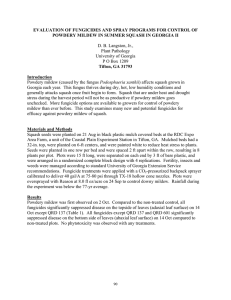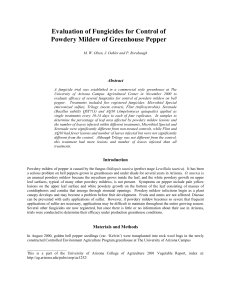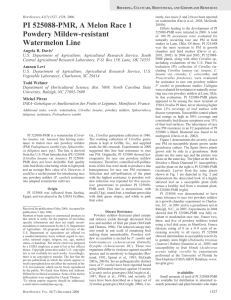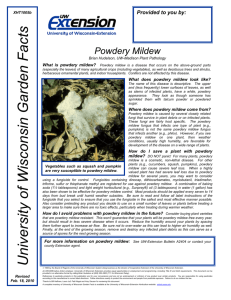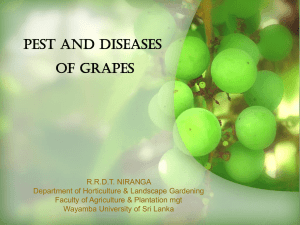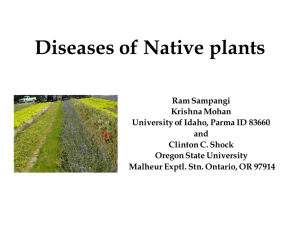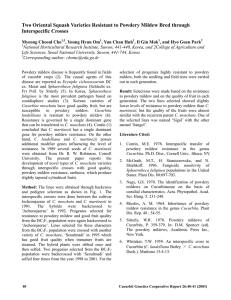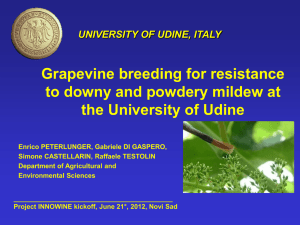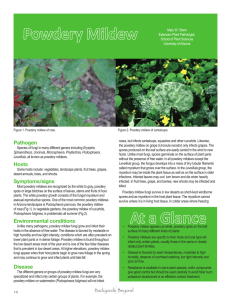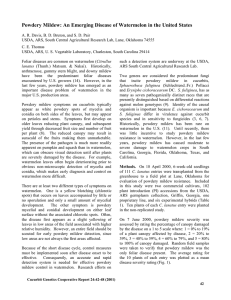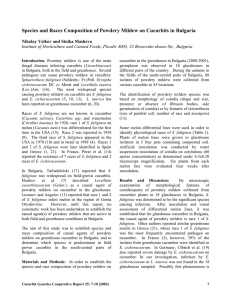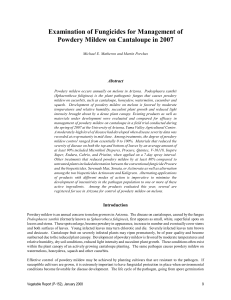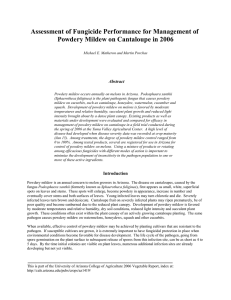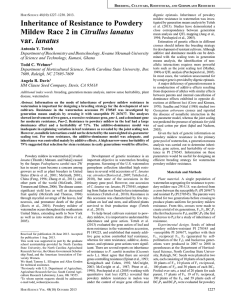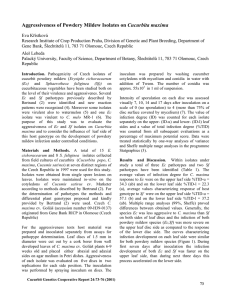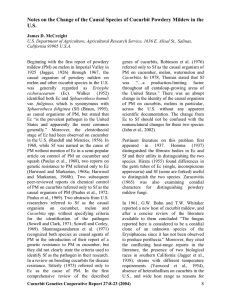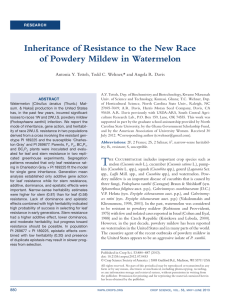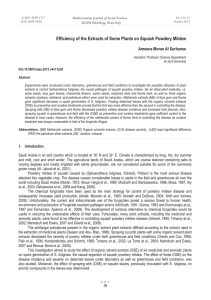Georgia Extension Vegetable News Cooperative Extension Service The University of Georgia
advertisement
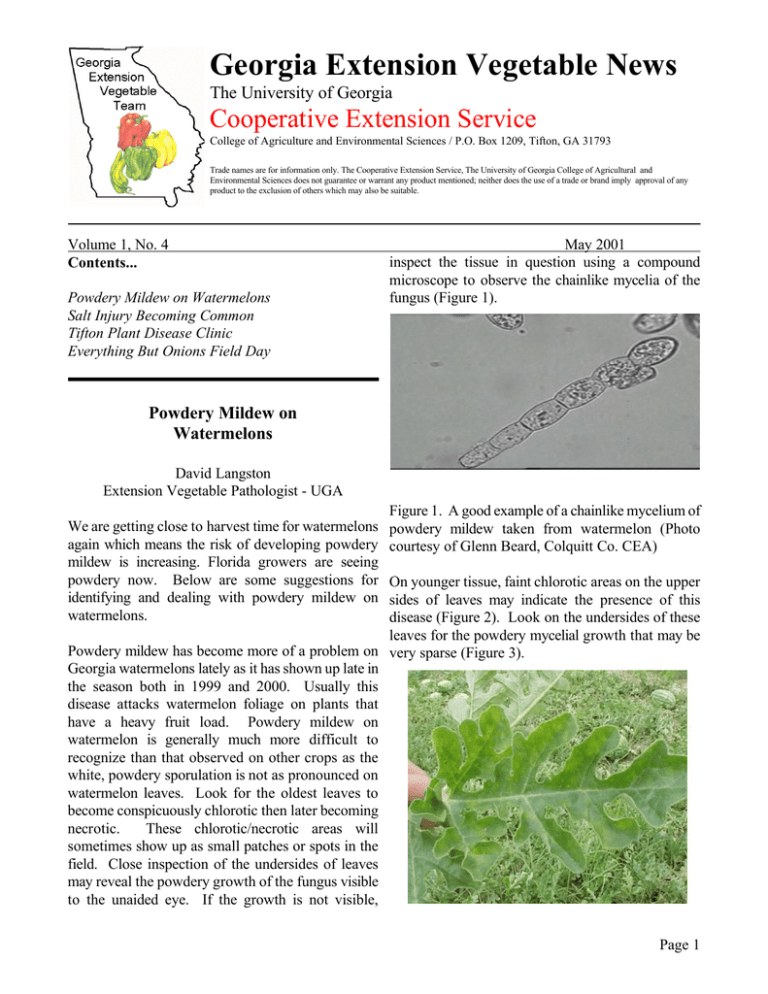
Georgia Extension Vegetable News The University of Georgia Cooperative Extension Service College of Agriculture and Environmental Sciences / P.O. Box 1209, Tifton, GA 31793 Trade names are for information only. The Cooperative Extension Service, The University of Georgia College of Agricultural and Environmental Sciences does not guarantee or warrant any product mentioned; neither does the use of a trade or brand imply approval of any product to the exclusion of others which may also be suitable. Volume 1, No. 4 Contents... Powdery Mildew on Watermelons Salt Injury Becoming Common Tifton Plant Disease Clinic Everything But Onions Field Day May 2001 inspect the tissue in question using a compound microscope to observe the chainlike mycelia of the fungus (Figure 1). Powdery Mildew on Watermelons David Langston Extension Vegetable Pathologist - UGA We are getting close to harvest time for watermelons again which means the risk of developing powdery mildew is increasing. Florida growers are seeing powdery now. Below are some suggestions for identifying and dealing with powdery mildew on watermelons. Figure 1. A good example of a chainlike mycelium of powdery mildew taken from watermelon (Photo courtesy of Glenn Beard, Colquitt Co. CEA) On younger tissue, faint chlorotic areas on the upper sides of leaves may indicate the presence of this disease (Figure 2). Look on the undersides of these leaves for the powdery mycelial growth that may be Powdery mildew has become more of a problem on very sparse (Figure 3). Georgia watermelons lately as it has shown up late in the season both in 1999 and 2000. Usually this disease attacks watermelon foliage on plants that have a heavy fruit load. Powdery mildew on watermelon is generally much more difficult to recognize than that observed on other crops as the white, powdery sporulation is not as pronounced on watermelon leaves. Look for the oldest leaves to become conspicuously chlorotic then later becoming necrotic. These chlorotic/necrotic areas will sometimes show up as small patches or spots in the field. Close inspection of the undersides of leaves may reveal the powdery growth of the fungus visible to the unaided eye. If the growth is not visible, Page 1 becomes mature. The affected areas of the leaf will be yellow and have a sandpapery feel to them. The condition does not always cause economic damage. However, if it begins early enough in the life of the plant, it can cause severe yield losses. Figures 2 and 3 showing chlorosis and powdery growth, respectively. Control of powdery mildew in watermelons relies on the timely application of fungicides such as Quadris, Flint and Nova. Of these, Nova has been shown to be the most effective on powdery mildew in Georgia. However, Nova should be tank-mixed with either chlorothalonil or mancozeb products to broaden the control spectrum as Nova will suppress powdery mildew only. Salt Injury Becoming Common Terry Kelley Extension Vegetable Specialist - UGA To date, all cases identified in Georgia have been on cucurbits grown on plastic. Except for pumpkins, the injury has not appeared in any bareground culture. The cause of the problem is still somewhat of a mystery. Numerous soil and tissue analyses done on affected areas have not revealed any apparent abnormalities. Tissue analysis on affected tissue will result in normal readings for most values with the exception of nitrogen which will be low in affected leaves. Soil analysis in every case has returned normal results. It is thought that the condition is the result of an accumulation of something in the soil that normally leaches out. As of yet, there has been nothing identified that has accumulated in excessive amounts. Due to the extended drought, the use of plastic mulch to cover fields and use of low volume irrigation, there is much less leaching in some fields than would normally occur. Efforts are currently underway to identify the culprit that is causing this condition. So far there has been no common ground identified except for plastic mulch. Symptoms have occurred under various fertilizer regimes and across varieties. Further details will be made known as information is collected. Salt injury has been showing up in several fields this spring. So far the problem has appeared mainly on cantaloupe and squash. Cucurbits are the most susceptible and the condition has been identified on pumpkins in the last year as well. To date, no major problems have been reported for cucumbers and watermelon. Isolated appearances of the injury in Georgia were identified in 2000 on cantaloupes and pumpkins. However, several cases have been reported this season. Salt injury is usually characterized by an initial “rim firing” appearing as a yellow band around the outer edge of the leaf. This can then spread to yellow Figures 4 - 7 demonstrating yellowing associated with splotches on the leaf as it worsens (Figures 4 - 7). salt injury. The condition normally appears on older leaves only. New growth will not show the symptoms until it Page 2 Tifton Plant Disease Clinic Pole Bean: Fusarium Yellows Snap Bean: Alternaria Leaf Spot Rhizoctonia Root Rot Nutrient Deficiency (3) Thrips Injury Unknown Squash: Phytophthora capsici (2) Pythium Root Rot Alternaria Leaf Blight Excessive Nitrogen Sweet Corn: Common Rust Tomato: No Disease Watermelon: Gummy Stem Blight Pythium Root Rot (3) Fusarium Wilt (4) Rhizoctonia Root and Stem Jason Brock Plant Disease Diagnostician -UGA In last month’s newsletter, I hypothesized that “with the plants being in the field, a wider range of diseases might be seen.” The host and pathogens were in place, but the third component of the disease triangle - the environment - was not ideal for plant disease. Many of the samples received were diagnosed as being a result of chemical, environmental, or nutritional disorders. Most of the diseases seen in the clinic were soil-borne; the one area that would have moisture delivered through irrigation. The lack of foliar diseases was likely related to the lack of long periods of leaf wetness. With a recent rain event, and possibly more on the way, stressed plants might be predisposed to disease. Rot Alternaria Leaf Blight Physical Injury No Disease (4) Unknown Fertilizer Burn (3) Chemical Phytotoxicity (2) Poor Pollination Ozone Injury The following is a summary of the commercial vegetable samples received during the past month. Cabbage: Oedema Cantaloupe: Gummy Stem Blight Cold Injury Inadequate Sample Chemical Phytotoxicity Collard: Downy Mildew Oedema Onion: Purple Blotch (2) Stemphylium Leaf Blight Chemical Phytotoxicity Peas: Fusarium Root Rot Pepper: Pythium Root Rot TSWV No Disease Insect or Physical Injury Nutrient Deficiency Blossom-End Rot Chemical phytotoxicity Everything But Onions Field Day Spring/Summer Fruits & Vegetables George Boyhan Extension Vegetable Specialist - UGA Location Vidalia Onion and Vegetable Research Center 8163 Hwy 178 Lyons, GA 30436 Date June 14, 2001 Time 6:00 pm – 8:00 pm Contacts George Boyhan (912) 681-5639 (912) 682-3481 Mobile Page 3 Agenda Georgia Extension Vegetable News Welcome and Convocation Volume 1, No.4. May 2001 Editor . . . . . . . . . . . . . . David B. Langston, Jr. Production Assistant & Webmaster . Paul Sumner Sponsored Supper Visit Field Plots Dr. Phil Brannen Dr. David Langston Dr. Terry Kelley Dr. George Boyhan Dr. Gerard Krewer Methyl Bromide Alternatives in Strawberry Production Cantaloupe Production on Plastic Carrot Trial Squash Trial Watermelon Trial Cantaloupe Trial Roma Tomato Trial Potential New Crops Blackberry Trellis Experiment The Georgia Extension Vegetable News is published bimonthly for Jan-Feb, Sept-Oct, and Nov-Dec and monthly March-Aug. This newsletter is also available on the World Wide Web at www.cpes.peachnet.edu/veg or www.ugaveg.org. Directions to VOVRC From Reidsville, GA take Hwy 147 south past the Georgia State Prison (on the right) and Rogers State Prison (on the left) and just after you cross the Toombs County line look for the brown and black sign for the Vidalia Onion and Vegetable Research Center on the right. Pull in that driveway and through the gate to the office. From Lyons, GA take Hwy 178 southeast past Stanleys Store and look for the Vidalia Onion and Vegetable Research Center sign on your left. If you cross into Tattnall County you have gone too far. Pull in that driveway and through the gate to the office. Page 4


